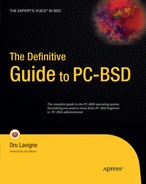For years, the BSD family of operating systems has been a popular choice for developers and system administrators. The BSDs provide well-engineered development processes, secure and stable operating systems, well-written documentation, and a license that allows users to freely modify the system to meet their needs. However, it was traditionally difficult for a casual computer user to get started using a BSD system due to an initially steep learning curve. What was needed was a desktop BSD that allowed usersto start using the operating system immediately and still allowed them to "peek under the hood" as they wanted to increase their knowledge of how things work.
The PC-BSD project was started in 2005 to address this need and has since matured into a stable, feature-rich, and easy-to-use operating system. Its userbase and popularity continue to grow among existing BSD users and users who are looking for alternatives to Windows, Mac, or Linux. Just as Ubuntu has revolutionized the Linux desktop, PC-BSD has revolutionized the BSD desktop.
PC-BSD has been designed to appeal to everyone, from casual computer user to the most advanced computer hacker. Things "just work," meaning you don't have to know how things work just to get them to work. Things are also infinitely customizable, where the only limit is literally how much you are willing to learn. PC-BSD is also suited to users with special needs—it can be easily customized for users with disabilities or users who read languages other than English.
PC-BSD also provides a vibrant community of end users, translators, writers, and developers. If joining an open source community interests you, you'll enjoy the friendliness, enthusiasm, and helpfulness of other PC-BSD users.
It is our hope that you enjoy the information in this book and learn all kinds of interesting things as you read through it. This book is meant to be "done" as much as "read," and every page contains something you'll want to try out on a system. So, grab a computer, the latest version of PC-BSD, and prepare to explore the PC-BSD operating system!
The Definitive Guide to PC-BSD is divided into five parts that move the reader from basic to advanced tasks. Novice users will benefit from reading the book from the beginning while more advanced users can start at the sections that catch their interest. If you come across a technical term you don't understand and it is not explained in that section, it was introduced earlier on in the book.
Part 1 is meant to get you started with PC-BSD. It provides an introduction to free and open source software, the BSD family of operating systems, and how PC-BSD fits into the picture. It then gets you started with PC-BSD by showing you how to run a live DVD or install PC-BSD into a virtual environment or directly onto your computer, either to run the DVD as a live operating system or to install PC-BSD on your system.
Part 2 allows you to get comfortable with using PC-BSD. Its beginning chapters introduce you to the KDE4 desktop, showing you how to customize your desktop and to find the things you need. It also shows you how to perform common computing tasks using PC-BSD. Later chapters show you how to change and configure every aspect of your operating system. If you're looking for a reference on "how do I?", this is the section of the book to zero in on.
Part 3 teaches you how to find, install, and manage software on your PC-BSD system. The initial chapters introduce you to PC-BSD's push button installer system that allows even brand-new users to safely manage their software. Later chapters introduce more advanced software management systems such as the FreeBSD packages system and the FreeBSD ports system.
Part 4 introduces you to the PC-BSD community and the resources that are available when you need help using your PC-BSD system. Users new to the open source way of doing things can learn about netiquette and how to effectively use forums, wikis, IRC, and mailing lists. This section of the book initially shows you how to get help and its later chapters provide suggestions on how more advanced users can give back to the PC-BSD community.
Part 5 is the most advanced section of the book. Its first chapter shows you how to perform advanced tasks such as creating customized installations, setting up a thin client network, and managing FreeBSD jails. The last chapter introduces you to the PC-BSD system and PBI development processes and shows how developers can assist the PC-BSD community.
